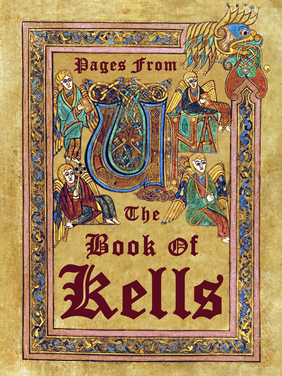In the Library of Trinity College, Dublin, there is a book (now re-bound in four volumes) of such surpassing beauty that it has been said to have been the work of Angels rather than men. It is called ‘The Book of Kells’ and contains the Gospels of Matthew, Mark, Luke and John, and some other texts, notably the Canonical Tables devised by Bishop Eusebius. The date of its writing is not known for certain but it would have been done before the 9th Century AD.
This book was written by monks, probably on the island of Iona where St Columba established a community centuries before. The book itself (supposed to be same work) is sometimes referred to as ‘The Great Gospel Book of Columbcille’ since it is referred to as such when it was stolen from Kells in Ireland in the year 1007AD. It was later found buried in the earth, shorn of its cover. There are also stories that, after its first being written, it was removed from Iona to Kells in Ireland. This was to save it from the ravages of the Vikings. Indeed, it is recorded that there was a particulaly devastating raid by Vikings in the year 806AD and it is likely to have been removed to Kells at that time.
The book had further travels. During Cromwell’s assault on Ireland it was taken to Dublin for safety. In 1661 it was given to Henry Jones, Bishop of Meath. From thence it found its way to Trinity College, Dublin, where it is now on display in four volumes. A rather careless bookbinder of the 19th century rebound it, ensuring that all the folios would be the same size. In doing so, some of the precious calligraphy and illumination at the page heads were destroyed. All in the pursuit of uniformity!
The manuscript on display nowadays consists of 340 folios of high quality vellum. This vellum (calfskin hide) demanded the availability of at least 150 calves and the preparation involves both hairside and fleshside writing surfaces. The writing is in iron gall ink which has lasted in its vibrancy to this day. The colours were obtained from a variety of sources from far and near. Some of the pages show evident water damage.
The text is drawn from the Latin Vulgate of St Jerome, though there are passages which indicate that previous sources, known as the Vetus Latina were used. The script is generally called ‘Insular Majuscule’ which is a form of Uncial or Half-uncial script. The writing styles have been studied and it is believed that there were at least three scribes working on the text, each with minor variations in the lettering. The decoration includes pictures of varying quality and many curious decorative features, including intertwined humans, animals and mythical beasts. There are intricate Celtic knots and Christian symbols.
The Book fo Kells is a remarkable work of art and one of the greatest treasures of the Western World.
Rod Dawson





